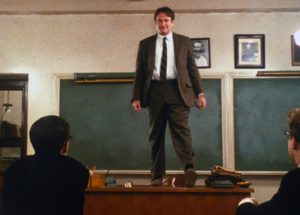The BEST: Dead Poets Society

The BEST: Dead Poets Society
Alex Israel – alexisrael.org

Summary: Set in 1959 at an elite boarding school, the movie tells of a young poetry teacher, Mr. John Keating, who inspires his students to challenge convention and to seek their own individuality, passions and creativity. However, romantic optimism and iconoclastic dreams collapse as tragedy strikes. Peter Weir’s stunning cinematography and Robin Williams’ larger than life personality bring the movie to life.
Consumption Time: 2 hours 8 minutes
Why this is the BEST: The film made an enormous impact on me as a young student, as a young madrich. It certainly played a role in my decision to enter Jewish Education. The Carpe Diem spirit, “I went to the woods, because I wished to live deliberately… and not, when I came to die, discover that I had not lived,” spoke to my search for a meaningful identity and a life-mission. It fired my idealism. I felt challenged by Mr. Keating’s mesmerising words, “That the powerful play goes on and you may contribute a verse… What will your verse be?” The “courtyard scene” in which Keating warns his students about the dangers of conformity – “find your own walk” – spoke to my need to express my authenticity, and, during my formative years, to differentiate myself from my community and seek my own ideal path.
A charismatic educator is out of the box, creative, close to his students, idealistic, funny, inspirational, rejecting stale convention, and an iconoclast. This romantic view of what a true teacher and mentor could be – teaching students not mere information but what to live for, investing them with a love of English poetry, or in my case, Torah, Judaism, and Zionism – made this film just an enthralling, enchanting inspiration.
The movie also raises important discussions around creativity vs. conformity, individualism vs. structure / community, dreams vs. practicality, authenticity vs. compliance, and many other tensions that are present in our religious lives in a contemporary context.
Thoughts and Reflections: After having been so inspired by “O Captain, My Captain!” in my younger years, I am now thirty-years older and a more mature educator, as well as a parent. I find that my relationship to the movie has changed. I now focus more on the irresponsible dimensions of Mr. Keating. Having abandoned a position from which I could find no fault in that charismatic mentor, I have come to see him as deeply reckless.
An example: in one scene, Mr. Keating asks Neal if he has confronted his father about taking part in a play. Neal responds in the affirmative. Mr. Keating can see that he is lying; that he hasn’t followed his advice, but he drops it, and doesn’t follow through. The results are disastrous.
As a young youth-leader, all I could see was that passion – “make life extraordinary!” Now, as a father and a more experienced educator, I see things in a more complex way. Whereas some colleagues, especially after a variety of rabbinic scandals, have become allergic to charisma in the educational sphere, I still recognize its importance. And yet, today, I am far more wary of charisma than I once was. Then, I couldn’t see the dangers; now I find the film quite painful to watch. Despite an enduring love for the romantic aspects of Mr. Keating’s message, the joy of youth and the incredible poetry, I find myself frequently wincing. I would hesitate to employ Mr. Keating on my faculty.
And then again, I will always think of a cave by torchlight and continue to dream, when I hear the inspirational words of Tennyson:
…Tho’ much is taken, much abides; and tho’
We are not now that strength which in old days
Moved earth and heaven, that which we are, we are;
One equal temper of heroic hearts,
Made weak by time and fate, but strong in will
To strive, to seek, to find, and not to yield.
This is the eighth installment in TraditionOnline’s “The BEST” column, exploring exemplars of the best culture has to offer thinking religious people — click here for the series introduction and links to all entries in the series.
Published September 12, 2019
